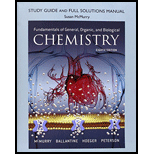
(a)
Interpretation:
The equilibrium constant for the given reaction is to be determined.
Concept Introduction:
Equilibrium constant is explains the relationship among reactant and product at equilibrium for a particular reaction.
The equilibrium constant expression is expressed by the formula,
It is the ratio of concentration of product raised to power of their corresponding coefficient of stoichiometry and concentration of reactant raised to power of their corresponding coefficient of stoichiometry at equilibrium.
(b)
Interpretation:
The equilibrium constant for the given reaction is to be determined.
Concept Introduction:
Equilibrium constant is explains the relationship among reactant and product at equilibrium for a particular reaction.
The equilibrium constant expression is expressed by the formula,
It is the ratio of concentration of product raised to power of their corresponding coefficient of stoichiometry and concentration of reactant raised to power of their corresponding coefficient of stoichiometry at equilibrium.
(c)
Interpretation:
The equilibrium constant for the given reaction is to be determined.
Concept Introduction:
Equilibrium constant is explains the relationship among reactant and product at equilibrium for a particular reaction.
The equilibrium constant expression is expressed by the formula,
It is the ratio of concentration of product raised to power of their corresponding coefficient of stoichiometry and concentration of reactant raised to power of their corresponding coefficient of stoichiometry at equilibrium.
(d)
Interpretation:
The equilibrium constant for the given reaction is to be determined.
Concept Introduction:
Equilibrium constant is explains the relationship among reactant and product at equilibrium for a particular reaction.
The equilibrium constant expression is expressed by the formula,
It is the ratio of concentration of product raised to power of their corresponding coefficient of stoichiometry and concentration of reactant raised to power of their corresponding coefficient of stoichiometry at equilibrium.
Want to see the full answer?
Check out a sample textbook solution
Chapter 7 Solutions
Study Guide And Full Solutions Manual For Fundamentals Of General, Organic, And Biological Chemistry
- Calculate the equilibrium concentration of H2O for the following esterification reaction performed in ethanol(C2H5OH) C2H5OH + CH3CO2H ⇌CH3CO2C2H5 + H2O KC= 4.0 At equilibrium: [CH3CO2H] = 0.75 M; [CH3CO2C2H5 ]= 2.2 Marrow_forwardFor the following reaction, 4.91 grams of water are mixed with excess chlorine gas. The reaction yields 12.5 grams of hydrochloric acid.chlorine (g) + water (l) hydrochloric acid (aq) + chloric acid (HClO3) (aq) What is the theoretical yield of hydrochloric acid ? grams What is the percent yield of hydrochloric acid ? %arrow_forwardTwo solutions, 250.0 mL of 1.00 M CaCl2(aq) and 250.0 mL of 1.00 M K2SO4(aq), are combined, and the temperature decreased by 2.40 degrees C. Determine qrxn per mole of CaSO4(s) formed in the reaction. A) +12.0 kJ/mol B) -12.0 kJ/mol C) +6.00 kJ/mol D) -6.00 kJ/molarrow_forward
- Where in the periodic table are the best reducing agents found? The best oxidizing agents?arrow_forwardIf you measured the rate of reaction at 20°C to be 1.11 x 10-5 M/s when using 0.080 M I1- and 0.040 M S2O82-. Approximately how long will the reaction take if you were to increase the temperature to 30 °C?arrow_forwardFor the series of reactions below, what is the overall reaction and the value of ∆Go’(kJ/mol) for this set of reactions? Is the reaction spontaneous? (1) 2 Pi+ H2O ➔Pyrophosphate+ H2O (with 5 mM Mg2+) (2) (Mg)Pyrophosphate + AMP ➔(Mg)ATP (3) (Mg)ATP + creatine ➔creatine-phosphate + (Mg)ADParrow_forward
- Potassium, a silvery metal, reacts with bromine, a corrosive, reddish liquid, to yield potassium bromide, a white solid. Write the balanced equation, and identify the oxidizing and reducing agents.arrow_forwardConsider the following reaction at 25°C with the ΔG°’ = +1800 J/mol for the forward reaction.The molar concentrations at the beginning of the reaction were [A] = 19 mM and [B] = 10 mM.After 1 hour, the concentrations were [A] = 16 mM and [B] = 13 mM. Calculate the ΔG of the reaction at the 1 hour timepoint. Please round to 1 decimal point.Gas constant = 8.315 J/mol Karrow_forwardCalculate the Keq (report up to two decimal places and do not use scientific notation) for the net reaction at 298.15K. (see attached image) Note: R = 1.98 x 10 -3 kcal/mol-Karrow_forward
- Write net ionic equations for the following reactions:arrow_forwardWrite a balanced equation for the combustion of isooctane to yield CO2 and H2O.arrow_forwardWhen the following equation of a redox reaction in acidic solution is properly balanced, what are the coefficients for Cr2O72–, Fe2+ H+, Cr3+, Fe3+, and H2O, respectively? __Cr2O72– + __Fe2+ + __H+ --> __Cr3+ + __Fe3+ + __H2O (A) 1, 3, 14, 2, 3, 7; (B) 1, 6, 14, 2, 6, 7; (C) 2, 10, 14, 2, 10, 7; (D) 2, 12, 28, 4, 12, 14arrow_forward
 BiochemistryBiochemistryISBN:9781319114671Author:Lubert Stryer, Jeremy M. Berg, John L. Tymoczko, Gregory J. Gatto Jr.Publisher:W. H. Freeman
BiochemistryBiochemistryISBN:9781319114671Author:Lubert Stryer, Jeremy M. Berg, John L. Tymoczko, Gregory J. Gatto Jr.Publisher:W. H. Freeman Lehninger Principles of BiochemistryBiochemistryISBN:9781464126116Author:David L. Nelson, Michael M. CoxPublisher:W. H. Freeman
Lehninger Principles of BiochemistryBiochemistryISBN:9781464126116Author:David L. Nelson, Michael M. CoxPublisher:W. H. Freeman Fundamentals of Biochemistry: Life at the Molecul...BiochemistryISBN:9781118918401Author:Donald Voet, Judith G. Voet, Charlotte W. PrattPublisher:WILEY
Fundamentals of Biochemistry: Life at the Molecul...BiochemistryISBN:9781118918401Author:Donald Voet, Judith G. Voet, Charlotte W. PrattPublisher:WILEY BiochemistryBiochemistryISBN:9781305961135Author:Mary K. Campbell, Shawn O. Farrell, Owen M. McDougalPublisher:Cengage Learning
BiochemistryBiochemistryISBN:9781305961135Author:Mary K. Campbell, Shawn O. Farrell, Owen M. McDougalPublisher:Cengage Learning BiochemistryBiochemistryISBN:9781305577206Author:Reginald H. Garrett, Charles M. GrishamPublisher:Cengage Learning
BiochemistryBiochemistryISBN:9781305577206Author:Reginald H. Garrett, Charles M. GrishamPublisher:Cengage Learning Fundamentals of General, Organic, and Biological ...BiochemistryISBN:9780134015187Author:John E. McMurry, David S. Ballantine, Carl A. Hoeger, Virginia E. PetersonPublisher:PEARSON
Fundamentals of General, Organic, and Biological ...BiochemistryISBN:9780134015187Author:John E. McMurry, David S. Ballantine, Carl A. Hoeger, Virginia E. PetersonPublisher:PEARSON





